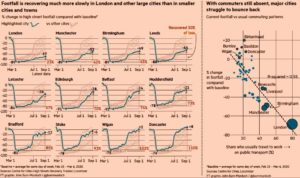
katielwhite91 (CC0), Pixabay
Even before the COVIP 19 crisis and the consequent looming economic recession labour market researchers and employment experts were concerned at the prospects for the future of work due to automation and Artificial Intelligence.
The jury is still out concerning the overall effect of automation and AI on employment numbers. Some commentators have warned of drastic cuts in jobs, more optimistic projections have speculated that although individual occupations may suffer, the end effect may even be an increase in employment as new occupations and tasks emerge.
There is however general agreement on two things. The first is that there will be disruption to may occupations, in some cases leasing to a drastic reduction in the numbers employed and that secondly the tasks involved in different occupations will change.
In such a situation it is necessary to provide pathways for people from jobs at risk due to automation and AI to new and hopefully secure employment. In the UK NESTA are running the CareerTech Challenge programme, aimed at using technology to support the English Government’s National Retraining Scheme. In Canada, the Brookfield Institute has produced a research report ‘Lost and Found, Pathways from Disruption to Employment‘, proposing a framework for identifying and realizing opportunities in areas of growing employment, which, they say “could help guide the design of policies and programs aimed at supporting mid-career transitions.”
The framework is based on using Labour Market Information. But, as the authors point out, “For people experiencing job loss, the exact pathways from shrinking jobs to growing opportunities are not always readily apparent, even with access to labour market information (LMI).”
The methodology is based on the identification of origin occupations and destination occupations. Origin occupations are jobs which are already showing signs of employment. Decline regardless of the source of th disruption. Destination jobs are future orientated jobs into which individuals form an origin occupation can be reasonably expected to transition. They are growing, competitive and relatively resilient to shocks.
Both origin and destination occupations are identified by an analysis of employment data.
They are matched by analysing the underlying skills, abilities, knowledge, and work activities they require. This is based on data from the O*Net program. Basically, the researchers were looking for a high 80 or 90 per cent match. They also were looking for destination occupations which would include an increase in pay – or at least no decrease.
But even then, some qualitative analysis is needed. For instance, even with a strong skills match, a destination occupation might require certification which would require a lengthy or expensive training programme. Thus, it is not enough to rely on the numbers alone. Yet od such pathways can be identified then it could be possible to provide bespoke training programmes to support people in moving between occupations.
The report emphasises that skills are not the only issue and discusses other factors that affect a worker’s journey, thereby, they say “grounding the model in practical realities. We demonstrate that exploring job pathways must go beyond skills requirements to reflect the realities of how people make career transitions.”
These could include personal confidence or willingness or ability to move for a new job. They also include the willingness of employers to look beyond formal certificates as the basis for taking on new staff.
The report emphasises the importance of local labour market information. That automation and AI are impacting very differently in different cities and regions is also shown in research from both Nesta and the Centre for Cities in the UK. Put quite simply in some cities there are many jobs likely to be hard hit by automation and AI, in other cities far less. Of course, such analysis is going to be complicated by COVID 19. Cities, such as Derby in the UK, have a high percentage of jobs in the aerospace industry and these previously seemed relatively secure: this is now not so.
In this respect there is a problem with freely available Labour Market Information. The Brookfield Institute researchers were forced to base their work on the Canadian 2006 and 2016 censuses which as they admit was not ideal. Tn the UK data on occupations and employment from the Office of National Statistics is not available at a city level and it is very difficult to match up qualifications to employment. If similar work is to be undertaken in the UK, there will be a need for more disaggregated local Labour Market Information, some of it which may already be being collected through city governments and Local Economic Partnerships.









